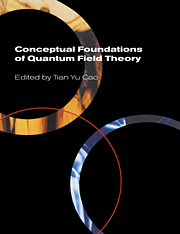Book contents
- Frontmatter
- Contents
- List of contributors
- Preface
- Photographs of the conference
- Introduction: Conceptual issues in quantum field theory
- Part One Philosophers' interest in quantum field theory
- Part Two Three approaches to the foundations of quantum field theory
- 3 The usefulness of a general theory of quantized fields
- 4 Effective field theory in condensed matter physics
- 5 The triumph and limitations of quantum field theory
- 6 Comments
- Part Three
- Part Four Mathematics, statistics and quantum field theory
- Part Five Quantum field theory and space-time
- Part Six
- Part Seven Renormalization group
- Part Eight Non-Abelian gauge theory
- Part Nine The ontology of particles or fields
- Part Ten
- Name index
- Subject index
4 - Effective field theory in condensed matter physics
Published online by Cambridge University Press: 22 September 2009
- Frontmatter
- Contents
- List of contributors
- Preface
- Photographs of the conference
- Introduction: Conceptual issues in quantum field theory
- Part One Philosophers' interest in quantum field theory
- Part Two Three approaches to the foundations of quantum field theory
- 3 The usefulness of a general theory of quantized fields
- 4 Effective field theory in condensed matter physics
- 5 The triumph and limitations of quantum field theory
- 6 Comments
- Part Three
- Part Four Mathematics, statistics and quantum field theory
- Part Five Quantum field theory and space-time
- Part Six
- Part Seven Renormalization group
- Part Eight Non-Abelian gauge theory
- Part Nine The ontology of particles or fields
- Part Ten
- Name index
- Subject index
Summary
I am presumably here to give you my perspective on quantum field theory from the point of view of a condensed matter theorist. I must begin with a disclaimer, a warning that I may not be really representing anyone but myself, since I find myself today working in condensed matter after following a fairly tortuous route. I must begin with a few words on this, not only since it will allow you to decide who else, if any, I represent, but also because my past encounters with field theory will parallel that of many others from my generation.
I started life in electrical engineering, as Professor Schweber said in the introduction. As an electrical engineering student, the only field theorists I knew about were Bethe and Schwinger, who had done some basic work on wave guides. When I graduated, I switched to physics and was soon working with Geoff Chew at Berkeley on particle physics. In those days (sixties and early seventies), the community was split into two camps, the field theorists and the S-matricists, and Geoff was the high priest of the latter camp. The split arose because, unlike in QED, where everyone agreed that the electron and the proton go into the Lagrangian, get coupled to the photon and out comes the hydrogen atom as a composite object, with strong interactions the situation seemed more murky.
- Type
- Chapter
- Information
- Conceptual Foundations of Quantum Field Theory , pp. 47 - 55Publisher: Cambridge University PressPrint publication year: 1999
- 7
- Cited by



